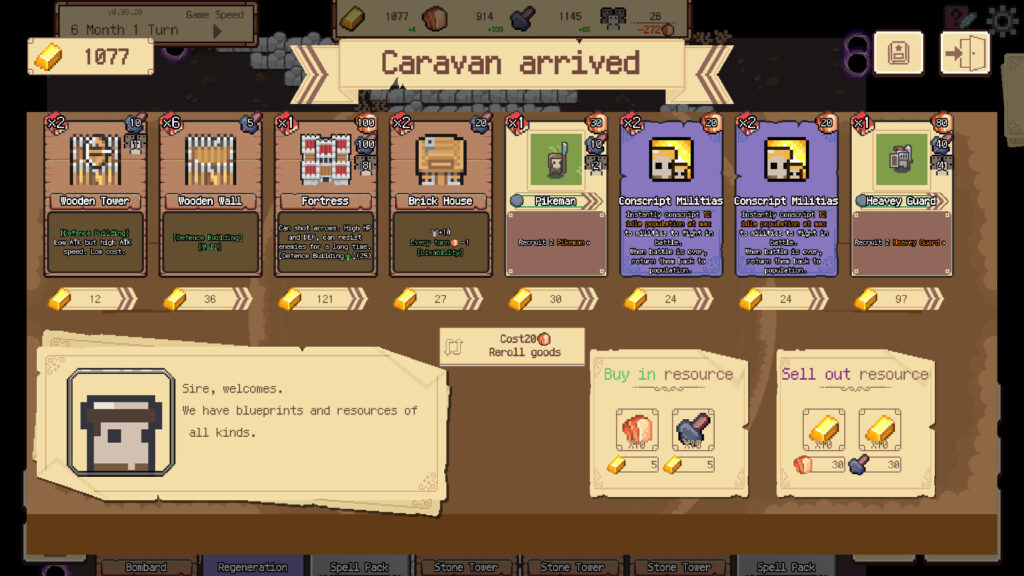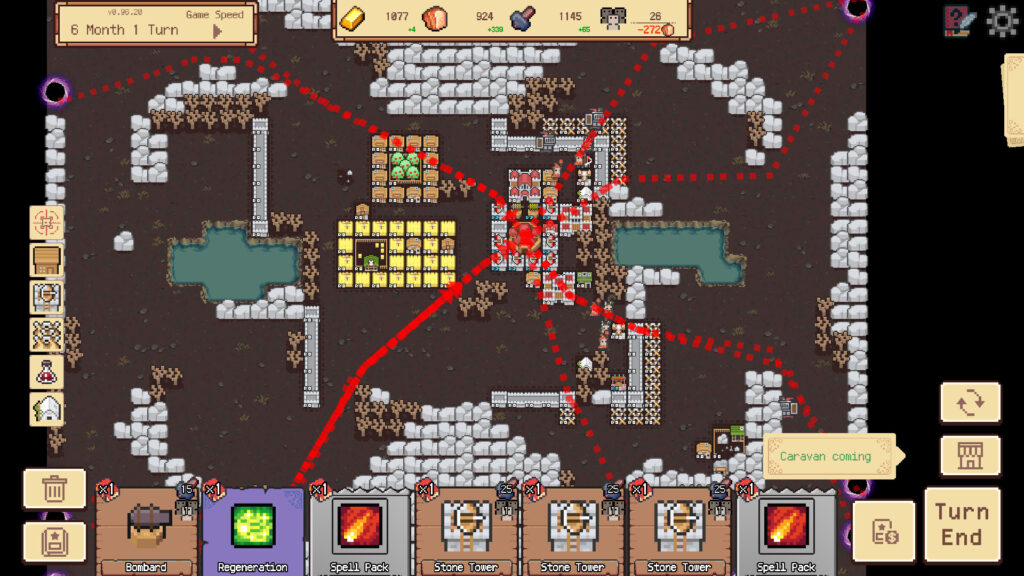Building a Frontier With Brains, Not Brute Force
Border Pioneer is a turn-based strategy game that blends the careful planning of a city builder, the fast-paced tension of tower defense, and the randomness of card-based gameplay into something that feels genuinely new. Developed by Gamer Sky Games and published by Yogscast Games, it’s part roguelike, part base sim, and part deckbuilder—with enough depth and charm to satisfy strategy veterans and indie fans alike.
Though its pixel-art visuals may look unassuming, this is one of those quiet indie titles that sneaks up on you. The core gameplay loop—draw cards, place buildings, defend your base, repeat—is easy to learn, but hard to put down. And beneath the surface lies a complex system of synergies, AI behaviors, and resource juggling that rewards thoughtful planning.
The Premise: Cards, Castles, and Chaos
You play as a border lord assigned to tame dangerous frontier lands by building a sustainable settlement and defending it from waves of monsters. Everything you build—houses, farms, towers, mines, barracks—comes from a deck of cards that you draw and play each turn.
Each mission pits you against a series of increasingly tough waves, often with enemy portals spawning in unpredictable locations. Between waves, you expand your economy, improve your defenses, and react to kingdom decrees or merchant caravans. After surviving long enough, a boss fight may appear—and if you win, you can keep pushing into endless waves for extra challenge.
Every run is unique thanks to randomized card draws, changing enemy spawns, and unlockable “Aid to Camp” characters that influence your starting hand and playstyle.

Gameplay: Where Planning Is Power
At its core, Border Pioneer is about spatial strategy. Where you place a card is just as important as what the card is. Farms work best near fields. Mines are stronger near rocks. Markets make more gold when surrounded by houses. Towers are only effective if placed at choke points or with a clear line of fire.
This city-building meets tower-defense hybrid rewards players who think several turns ahead. You need to build an economy that can sustain growth and defense—but overbuild your farms or forget to upgrade towers, and your entire base might collapse under pressure.
You’re constantly asked to make tradeoffs:
- Do you place another house to gain workers, even though it will cost you food?
- Should you upgrade a tower now, or save resources for another barracks?
- Is that magic tree spell worth playing, or should you use the slot for a much-needed mine?
This strategic tension is what makes Border Pioneer so satisfying.
Cards and Companions: The Backbone of Your Build
Every building comes from a deck. You start each turn by drawing several cards—each with limited uses. You can sell or combine them, but you’re always working within tight constraints. That means adaptability is key.
You’ll also unlock companions, each with a unique twist: some start with military-heavy decks, others with better economic tools or magic synergies. These aid characters influence which cards appear and offer passive bonuses.
While the deckbuilding isn’t as deep as a game like Slay the Spire, it offers enough randomness and upgrade flexibility to keep each run feeling fresh. And since cards can be leveled up, sold, or replaced, you’re constantly evolving your strategy mid-run.

Combat: Tower Defense With Smart Pathfinding
Once you end your build phase, enemies begin their assault. They spawn from portals and head toward your base. The tower defense system in Border Pioneer is surprisingly elegant. Enemies take the shortest path, but they’ll destroy buildings in their way—meaning you can “maze” them with smart wall placement, but it has to be intentional and strategic.
Units behave intelligently:
- Melee troops engage directly.
- Ranged units hold position.
- Injured units retreat to heal, then rejoin the battle.
This minimal micromanagement means you can focus on macro-strategy, not babysitting individual troops.
Defensive tools include:
- Magic towers with homing attacks or lightning bolts.
- Pike guards for chokepoints.
- Spike traps and barricades to slow or damage enemies.
Watching your defenses survive (or barely collapse) is a tense and rewarding spectacle.
Economy & Base Systems
Your population, food supply, and gold income are constantly in flux. Too many houses and not enough farms? Your workers starve. Ignore gold production? You can’t afford card upgrades. Over-focus on defense? Your economy stagnates.
This tight economic balance makes every choice feel meaningful. Buildings influence each other’s efficiency, and placement bonuses encourage clever layouts.
Between rounds, you’ll also get random kingdom edicts or merchant events—offering buffs, penalties, or items for sale. These decisions further spice up each run, forcing you to weigh short-term risk against long-term survival.
Progression & Replayability
Outside of individual runs, Border Pioneer includes light meta-progression. You unlock new cards, talents, and companions over time. While there’s no elaborate skill tree, the drip-feed of options adds meaningful long-term variety.
Each mission is its own self-contained scenario, with randomized maps, different enemy types, and optional bosses. While the lack of a sandbox or endless mode is noticeable, the variety across missions and companion builds keeps the replay loop strong.
A full playthrough might take 10–15 hours—but dozens more if you’re experimenting with builds or chasing perfection.

🎯 Where Border Pioneer Hits the Mark
+ Strategic Layering That’s Deep but Accessible
The blend of card play, tower defense, and city management is tight and rewarding.
+ Satisfying Combat Loop
Enemy waves are tense, and smart AI makes each defense feel earned.
+ Replay Value Through Companions and Card Unlocks
Different builds and playstyles keep each run interesting.
+ Economy and Layout Matter
Spatial bonuses and population mechanics elevate the depth of each decision.
+ Price-to-Content Ratio Is Excellent
At $15, it offers far more depth than many bigger-budget games.
🛠️ Where It Could Improve
– UI Needs Refinement
Buff descriptions, card effects, and synergy indicators can be hard to read or missing entirely.
– Spell System Feels Underdeveloped
While spells exist (like summoning trees or launching fireballs), they’re often less impactful than units or buildings.
– Some Missions Feel Short
Without an endless or sandbox mode, long-term survival junkies might feel restricted.
– Visual Clarity During Busy Waves
Pixel-art units can get lost in crowded battles, making it hard to read the action.
Border Pioneer: Border Pioneer is one of the best-kept secrets in indie strategy this year. It’s sharp, flexible, and bursting with tactical possibilities. The fusion of base building, deck mechanics, and defense is more than a gimmick—it’s a brilliant foundation for a game that deserves a much wider audience. If you enjoy planning cities, surviving waves, or optimizing synergies, this belongs in your library. It’s not flashy, but it’s smart, satisfying, and endlessly replayable. – ColdMoon


